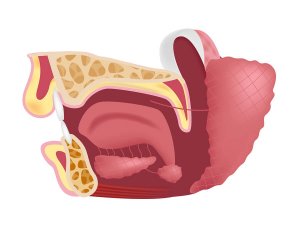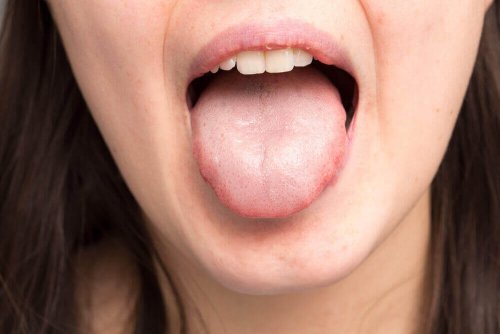What Are Submaxillary Glands For?


Written and verified by the doctor Leonardo Biolatto
The submaxillary glands can also be called submandibular glands and the name is due to its anatomical location in the skull, below the floor of the mouth.
Thus, they’re part of the set of major salivary glands, comprised by the submaxillary, parotid and sublingual glands. There is one parotid gland on each cheek, close to the ears, while the sublingual is under the tongue.
The submaxillary glands don’t weigh much, they’re only about less than 15 grams each. Also, it’s one of the first to appear in a young fetus. Of course, the formation of saliva is their main function.
Anatomy of the submaxillary glands
The submaxillary glands are made up of connective tissue and glandular tissue. There are two glandular types: serous and mucous. Likewise, the connective tissue contains the fibers that support the structure.
A duct starts from the gland itself and has the function of pouring saliva into the oral cavity. This submandibular duct is about 2 inches long.
The mouth of this duct is visible and palpable through the oral cavity. One can find it on either side of the lingual frenulum. Sometimes, to find out if the duct is blocked or not, the dentist must stimulate the glands and check to see whether saliva can come out.
The lingual nerves and some branches of the facial nerves reach the glands to order the production of saliva. This is an area heavily irrigated by arteries and veins, just like the whole mouth is.

The functions of saliva
If we ask what the submaxillary glands are for, then saliva production is the obvious answer. They are an important part of the salivary system.
Along with the parotid and sublingual glands, plus the minor salivary glands, these organs are responsible for supplying the mouth with saliva. If we understand the functions of saliva in the body, we can understand the reason for the submaxillary glands.
Saliva is a colorless liquid whose main function is to lubricate the mouth. In a full day, a person can produce up to a liter and a half of this substance. Its functions are to:
- Facilitate swallowing. When a person chews food it becomes soaked in saliva before beginning its journey to the rest of the digestive tract. This saliva coating lubricates this passage of the food bolus in order to facilitate its intake.
- Heal the mucosa. Saliva is a powerful antiseptic and protector and contains substances that prevent infections and stimulate healing when there’s a wound inside the mouth.
- Regulate the acidity of the oral environment. The food we eat can be acidic or basic. When the acidity values of the food are extreme, they may damage the dental enamel. So, to counteract it, saliva neutralizes the Ph of certain substances.
- Degrade starches. In saliva, there is an enzyme called alpha-amylase, which breaks down large carbohydrates to make them smaller and easier to get into the bloodstream. The hydrochloric acid there makes alpha-amylase inactive when it reaches the stomach.

Find out more: Coconut Oil for Improving Oral Health
Submaxillary gland diseases
Like any organ of the body, the submaxillary gland can suffer disorders and pathologies. It may be unknown to many, but dentists are well aware of their existence and associated problems.
Quite often, stones form and they obstruct the submandibular duct. Their technical name is sialoliths and they can inflame the gland if they’re too large and obstruct the outflow path of the saliva.
Sialoliths are rare in children but can appear sporadically. Thus, there’s a higher prevalence in adults below the age of 50.
There can also be an infection in the submaxillary glands. Both viruses and bacteria have the potential to invade salivary tissue, inflame it, and obstruct the submandibular duct.
Submaxillary glands – conclusion
The submaxillary glands are organs that are part of the set of major salivary glands, together with the parotid and sublingual glands. Thus, they fulfill the essential function of producing the saliva that we use daily.
In turn, saliva is essential for the digestion of food, to protect the oral mucosa, and to take care of the teeth. These processes alter when there’s a deficiency or an absence of saliva.
Finally, let’s not forget that the submaxillary glands can become infected and clogged with stones. Consult a dentist if you have symptoms in this area of your mouth.
All cited sources were thoroughly reviewed by our team to ensure their quality, reliability, currency, and validity. The bibliography of this article was considered reliable and of academic or scientific accuracy.
- Otón, Eduardo Treviño, Ruth Sánchez Sánchez, and Manuel Fernández Domínguez. “Sialolitiasis en glándula salival menor: a propósito de un caso.” Científica dental: Revista científica de formación continuada 15.1 (2018): 15-18.
- Gilloteaux J., Afolayan A. (2014). «Clarification of the Terminology of the Major Human Salivary Glands: Acinus and Alveolus are not Synonymous». The Anatomical Record. Oral Biology (American Association for Anatomy) 297 (8).
- Contreras, Carlos, et al. “Ubicación anatómica de las glándulas salivales linguales ó glandulas salivales menores presentes en la lengua.” Acta odontológica venezolana 46.2 (2008): 240-241.
This text is provided for informational purposes only and does not replace consultation with a professional. If in doubt, consult your specialist.








